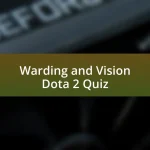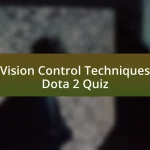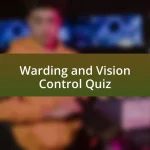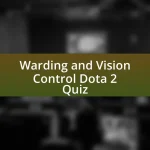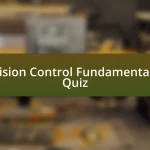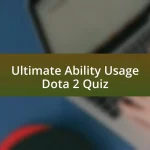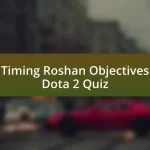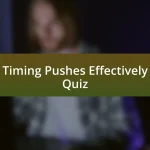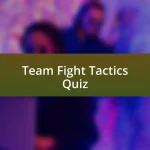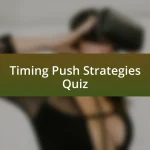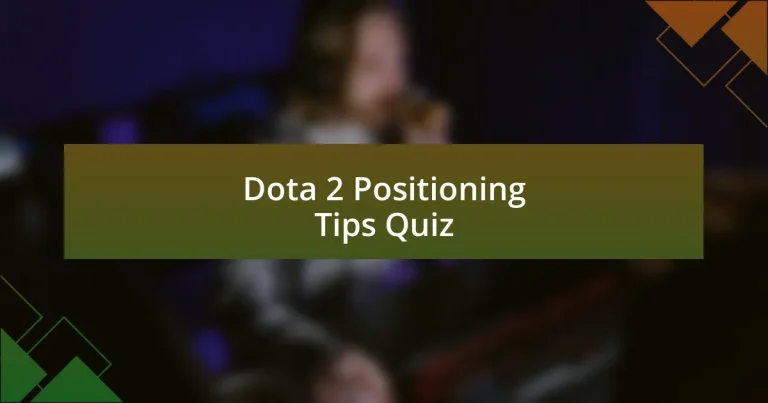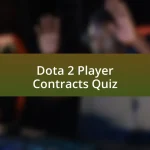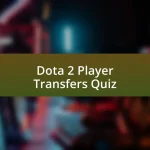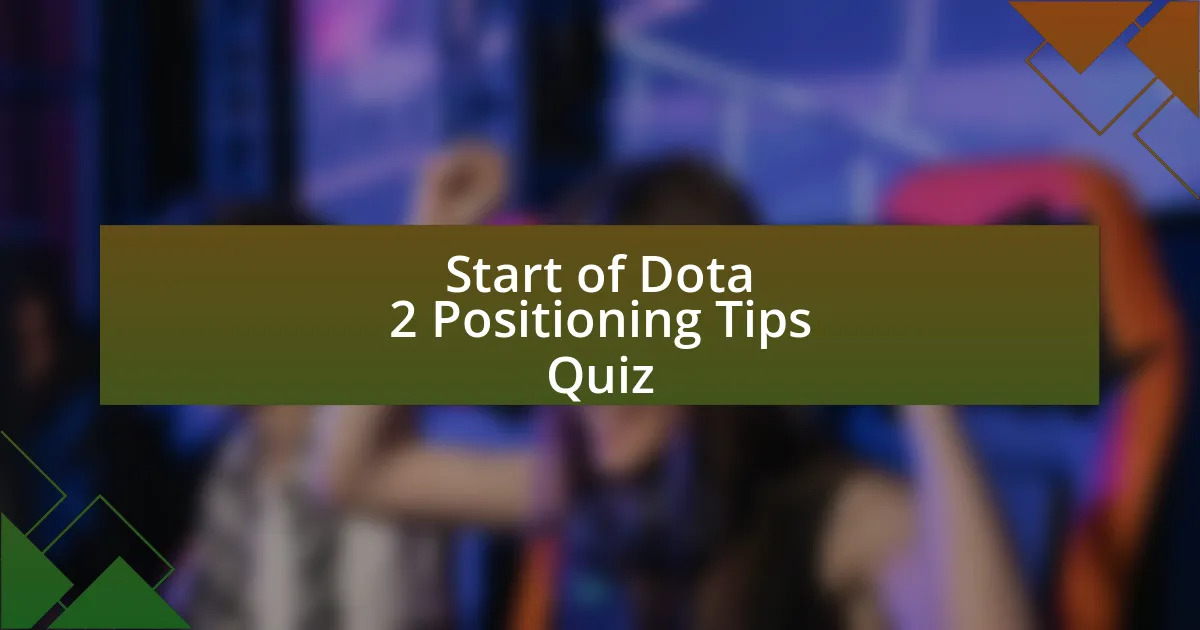
Start of Dota 2 Positioning Tips Quiz
1. What is positioning in Dota 2?
- Positioning is about the items a hero carries during a match.
- Positioning in Dota 2 refers to the location of your hero on the map, which is crucial for survival and gameplay.
- Positioning is only important in team fights and not in the laning phase.
- Positioning decides the hero`s attack speed in the game.
2. Why is good positioning important in Dota 2?
- Good positioning ensures you always get the most kills in the game.
- Good positioning helps you stay safe, cast spells correctly, and survive through ganks and team fights.
- Good positioning guarantees you will always win every team fight.
- Good positioning allows your hero to become invincible against all attacks.
3. What does high ground positioning achieve in Dota 2?
- It makes your hero invincible in all situations.
- It allows you to gain an advantage in battles.
- It decreases your team`s total damage output.
- It forces the enemy to surrender immediately.
4. How does map awareness help with positioning in Dota 2?
- Map awareness helps you avoid danger.
- Map awareness makes you deal more damage.
- Map awareness allows you to farm faster.
- Map awareness gives you extra abilities.
5. What are the three types of zones in static positioning?
- sight range, experience range, attack range
- charge zone, speed zone, ability zone
- vision zone, defense zone, movement zone
- damage zone, health zone, mana zone
6. Why is sight range crucial for heroes in Dota 2?
- It helps detect enemies effectively.
- It allows heroes to heal faster.
- It increases attack damage in fights.
- It provides extra experience gain.
7. What happens to a hero`s sight range during nighttime in Dota 2?
- A hero`s sight range becomes larger at night.
- A hero`s sight range disappears at night.
- A hero`s sight range becomes smaller at night.
- A hero`s sight range stays the same at night.
8. Why is attack range significant for heroes regarding positioning?
- It affects the amount of gold you earn from creeps.
- It determines how close you need to be to engage in fights.
- It defines the area where you can teleport.
- It increases the attack power of your hero.
9. How should melee heroes adapt to enemy ranged heroes` positioning?
- Melee heroes should stay close to enemy ranged heroes at all times.
- Melee heroes should always engage enemy ranged heroes head-on.
- Melee heroes should ignore positioning and just farm freely.
- Melee heroes should position to avoid enemy ranged heroes` attack ranges.
10. What is dynamic positioning in Dota 2?
- Dynamic positioning is when heroes communicate exclusively via chat commands.
- Dynamic positioning relies solely on auto-attacking without considering enemy locations.
- Dynamic positioning means standing still and waiting for the enemy to approach.
- Dynamic positioning involves guessing where the enemy team is and positioning your hero accordingly to stay safe and effective.
11. Which skills are essential for effective dynamic positioning?
- Item collection
- Healing abilities
- Farming skills
- Map awareness
12. How does game sense contribute to a hero`s positioning decisions?
- Game sense allows heroes to become invincible.
- Game sense increases a hero`s attack damage.
- Game sense eliminates the need for map awareness.
- Game sense helps players predict enemy movements.
13. What is the ideal map position for heroes during the laning phase?
- 1-3-1
- 2-1-2
- 3-0-2
- 0-5-0
14. Can you list the five main roles in Dota 2 and their importance for positioning?
- Assassin, Mage, Tank, Damage Dealer
- Carry, Midlaner, Offlaner, Soft Support, Hard Support
- Duelist, Sniper, Shielder, Aegis Bearer
- Healer, Scout, Berserker, Defender
15. How do hero roles influence positioning strategies in Dota 2?
- Positioning strategies are only important for carry heroes.
- Each hero role has specific positioning strategies based on their objectives and playstyles.
- All heroes can position themselves the same way regardless of role.
- Roles do not influence how heroes should position on the map.
16. What is the common positioning setup for heroes in the safelane?
- Offlaner with Midlaner
- Two Midlaners
- Two Offlaners
- Carry with Hard Support
17. What role does a Hard Support play in the safelane positioning?
- The Hard Support focuses on dealing damage to enemies.
- The Hard Support takes last hits and secures resources.
- The Hard Support protects the Carry while they farm.
- The Hard Support plays aggressively to zone out opponents.
18. How should a Midlaner position themselves effectively?
- A Midlaner positions themselves in the midlane, focusing on farming and controlling the center of the map.
- A Midlaner roams around the enemy jungle, avoiding the midlane entirely.
- A Midlaner camps in the offlane, helping the Offlaner secure kills.
- A Midlaner stays in the safelane, protecting the Carry and securing gold.
19. What positioning role does an Offlaner typically have in a game?
- Jungle
- Offlane
- Safelane
- Midlane
20. How does a Soft Support contribute to positioning in the offlane?
- A Soft Support only supports the Carry in the safelane.
- A Soft Support provides utility and assistance to the Offlaner.
- A Soft Support focuses on dealing the most damage in fights.
- A Soft Support is responsible for farming and building items quickly.
21. Why are item timings significant in determining hero positioning?
- Item timings affect the speed of hero movement only.
- Item timings determine a hero`s preferred color scheme.
- Item timings are irrelevant to gameplay decisions.
- Item timings dictate when heroes can engage and rotate safely.
22. How does Medusa optimize her positioning in the laning phase?
- Medusa focuses on farming while staying safe.
- Medusa constantly engages in fights early.
- Medusa avoids all interactions in the lane.
- Medusa only uses her abilities aggressively.
23. Why is vision vital for maintaining good positioning?
- Vision distracts you from your primary objective.
- Vision increases your attack speed significantly.
- Vision encourages reckless gameplay decisions.
- Vision allows you to anticipate enemy movements.
24. In what way does attack range affect hero positioning during engagements?
- A hero`s attack range determines how close they need to be to engage effectively.
- A hero`s attack range decides their health regeneration rate during battles.
- A hero`s attack range influences the cooldown of their abilities in a team fight.
- A hero`s attack range affects the amount of gold earned per creep killed.
25. What risks occur if you allow enemies too close during the laning phase?
- You risk making more allies.
- You risk taking unnecessary damage.
- You risk gaining gold quickly.
- You risk getting more experience.
26. What strategies can you use to handle harassment from opponents in lane?
- Stand still and take damage
- Always engage aggressively without backup
- Trade hits or kite opponents
- Ignore the enemies and farm
27. What is the purpose of side poles in the laning phase regarding positioning?
- Side poles provide healing to heroes.
- Side poles increase attack damage.
- Side poles help control creep waves.
- Side poles block enemy vision.
28. How does night-time change the dynamics of hero sight range?
- A hero`s sight range becomes smaller at night.
- A hero`s sight range remains the same at night.
- A hero`s sight range becomes larger at night.
- A hero`s sight range disappears entirely at night.
29. What strategies should a Bristleback Offlaner use for effective dynamic positioning?
- Stay close to enemy heroes to zone them out.
- Use map awareness to anticipate ganks.
- Focus solely on last-hitting creeps.
- Always engage in team fights regardless of positioning.
30. How can Pudge`s absence from the midlane influence a Bristleback`s positioning?
- The Bristleback will ignore map awareness and focus on farming.
- The Bristleback will roam to the enemy jungle to hunt heroes.
- The Bristleback will take aggressive fights and push forward.
- The Bristleback will play defensively and avoid risky engagements.

Congratulations! You’ve Completed the Quiz!
Well done on finishing the quiz on Dota 2 Positioning Tips! We hope you found it both enjoyable and informative. Positioning is crucial in Dota 2. It can often mean the difference between victory and defeat. You may have learned about the importance of map awareness, understanding your hero’s role, and the value of maintaining a safe distance from potential threats. These insights are key to enhancing your gameplay.
As you reflect on your answers, think about how you can apply these tips in your next match. Understanding proper positioning can not only improve your performance but also help your team achieve better synergy. Always remember that Dota 2 is a team game. Sharing knowledge and strategies with your teammates can create a more effective playing environment.
If you’re eager to dive deeper into this essential topic, we invite you to explore the next section on this page. It offers a wealth of information on Dota 2 Positioning Tips that will further expand your knowledge. Whether you are a newcomer or an experienced player, there’s always something new to learn. Happy gaming!
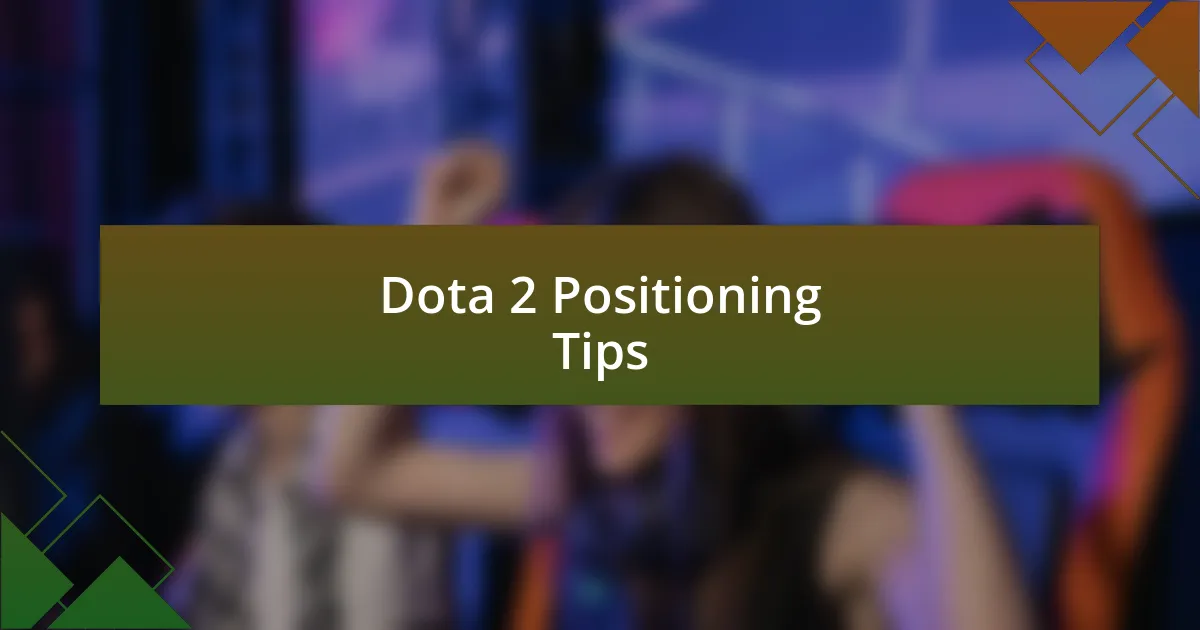
Dota 2 Positioning Tips
Understanding Positioning in Dota 2
Positioning in Dota 2 refers to the strategic placement of heroes during gameplay. Effective positioning helps players avoid unnecessary damage, control the battlefield, and support teammates. Proper positioning can significantly influence team fights and the overall game outcome, as players can react faster to threats or opportunities. Essential to mastering this aspect is recognizing the strengths and weaknesses of both your hero and your opponents.
The Importance of Awareness and Map Control
Awareness involves keeping track of enemy movements, allies’ locations, and potential threats. Good map control allows for effective positioning by providing information on where to place yourself during encounters. By analyzing the map frequently and knowing where enemy heroes are, players can choose optimal positions, avoiding ambushes and maximizing their effectiveness. This includes using wards and understanding vision advantages.
Positioning Based on Role and Hero Type
Your role in the team dictates your positioning strategy. Carries should position themselves in the backline during team fights, keeping safe from initiators while dealing damage. Support heroes must stay close enough to assist their teammates without becoming targets themselves. Tanks should lead engagements, absorbing damage and drawing attention away from squishier allies. Positioning effectively varies not just by role but also by the specific abilities and qualities of the chosen hero.
Using Terrain and Escape Routes Strategically
The terrain in Dota 2 can provide advantages when positioning your hero. High ground can offer vision and safety, while trees may allow for ambushes. Players should use chokepoints to funnel enemies or escape routes to retreat quickly when necessary. Understanding these geographical elements enhances your ability to navigate fights and avoid unfavorable positioning during engagements, contributing to survival and success in battles.
Adapting Positioning During Team Fights
During team fights, positioning requires constant adjustment based on the flow of battle. As fights develop, players must be ready to reposition to avoid crowd control or high-damage abilities from enemies. Staying aware of health levels, cooldowns, and the location of allies helps inform when to advance or retreat. Effective communication with your team about positional changes enhances group dynamics and unity in battle, leading to a higher chance of victory.
What are some effective Dota 2 positioning tips during team fights?
Effective Dota 2 positioning tips during team fights include staying behind your frontliners, maintaining vision, and being aware of the enemy’s crowd control abilities. Position yourself where you can deal damage without being easily targeted. For example, ranged heroes should position themselves at the edge of the fight to maximize damage output while minimizing risk. Monitoring the mini-map for potential ganks or flankers is critical, as well as using terrain to your advantage, like high ground or trees for cover.
How can I improve my positioning in Dota 2?
To improve your positioning in Dota 2, practice situational awareness and map awareness. Regularly glance at both the map and the location of your teammates and enemies. Use hotkeys to quickly access critical information such as your allies’ abilities and cooldowns. Analyze replays to identify mistakes in positioning, and adjust accordingly. Additionally, make use of the in-game indicators to visualize danger zones, which will help you avoid unnecessary deaths.
Where should I position my hero in the laning phase?
In the laning phase, position your hero near the creep wave but not too close to enemy heroes to avoid taking unnecessary damage. Ranged heroes should stay behind creeps and trade hits cautiously, while melee heroes may need to position themselves to secure last hits and deny effectively. Use the trees for cover to hide from enemy vision, and always be ready to pull back if the enemy jungler appears, as positioning can drastically affect your survivability and farming efficiency.
When is the best time to reposition in a Dota 2 match?
The best time to reposition in a Dota 2 match is during enemy spells or abilities that have long cooldowns or after key items have been used during a fight. For example, after an enemy initiates with a stun, repositioning can allow you to exploit the brief window of opportunity for counterplay. Additionally, if you notice an enemy hero missing from the map, safely reposition to a defensive area until your team confirms their absence.
Who should focus on positioning in a Dota 2 game?
All players should focus on positioning in a Dota 2 game, but it is particularly crucial for carries and supports. Carries need to position themselves to deal damage while staying safe, as they are often primary targets. Support heroes need to maintain a good position to provide utility and vision while being protected. Proper positioning for both roles can significantly impact the outcome of team fights and the overall game strategy.

